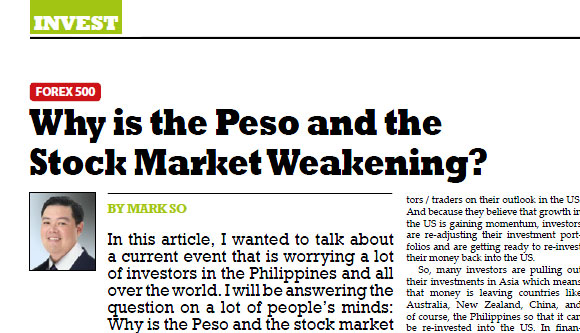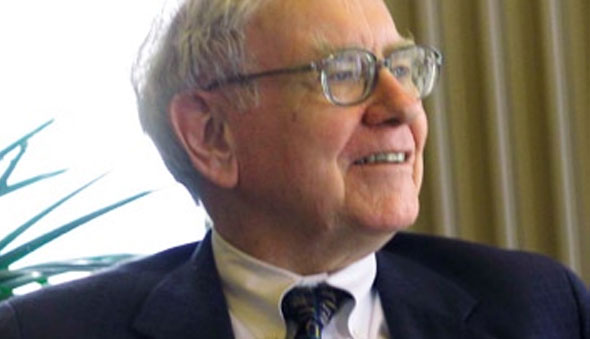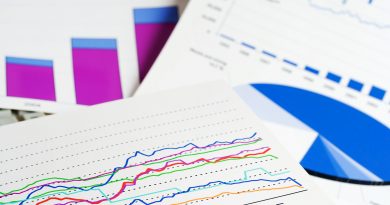Why is the Peso and the Stock Market Weakening?
By Mark So
In this article, I wanted to talk about a current event that is worrying a lot of investors in the Philippines and all over the world. I will be answering the question on a lot of people’s minds: Why is the Peso and the stock market weakening? I’ve arranged the article in a question and answer format so that it will be easier to digest.
Does our stock market also have an effect on the strength or weakness of the Peso? Why or why not?
Yes, our stock market has an effect on the Peso. First, you have to remember that there are two major groups investing in our stock market – foreign investors and local investors. Our stock market is dominated by foreign investments. According to the BSP, direct foreign investments into the Philippine stock market reached US$110 billion in 2012 which is double that of 2011 of US$50 billion. When foreign investments come in, they arrive on Philippine shores as foreign currencies, the most popular of which is of course the USD.
So to be able to invest in the Philippine Stock Exchange, the USD has to be converted into our local currency, the Peso. The conversion process is the USD has to be sold and the Peso bought. This means that there will be more USD supply and consequently, a smaller supply of Pesos in the Philippines. So the first thing that happens when foreign investments come in is a strengthening of the Peso.
Now, once foreign investors and even local investors have invested in the stock market, another conversion takes place. The Peso is converted into stocks or shares of companies. That means the Peso is sold and the shares bought. Therefore, the supply of Pesos increase, causing a weaker Peso while stocks of certain companies decrease, causing the stock market to rise.
So, based on what I mentioned above, the more foreign direct investments coming into the Philippines, the stronger the Peso will be. Then once the Peso is re-invested in let’s say the stock market or real estate, it weakens the Peso.
However one thing is certain, should foreign investments leave the country enmasse, it weakens the Peso significantly.
Can you explain why the Peso is suddenly weakening against the US Dollar when earlier forecasts were that it would settle below 40?
The Peso, like most Asian currencies, has been weakening against the USD for the past few weeks as many investors believe that economic growth is returning to the US. US economic data for the first half of the year, specifically employment has been surprisingly good which has helped change the minds of many investors / traders on their outlook in the US. And because they believe that growth in the US is gaining momentum, investors are re-adjusting their investment portfolios and are getting ready to re-invest their money back into the US.
So, many investors are pulling out their investments in Asia which means that money is leaving countries like Australia, New Zealand, China, and of course, the Philippines so that it can be re-invested into the US. In financial news outfits, they have coined this move as “international de-leveraging.”
To explain further, when money leaves a country, the money is converted back to its original currency form,let’s say the USD. In the case of the Philippines, as more investors pull out from investments in the Philippines, like the stock market, real estate, etc., the Peso will be sold and the money converted to USD. As more investments continue, the selloff of the Peso continues, causing the supply of Pesos to increase and causing the price of the Peso to drop. So the earlier forecast of the Peso strengthening to 40 and even 38 has been replaced by the new outlook on US growth.
What other things do we need to look out for that might affect our currency?
Our own economic growth, Inflation, and our own Central bank’s monetary policy, these are tree major fundamental reasons why a country’s currency rises or falls.
To protect ourselves from a weakening and a strengthening peso, I highly suggest you learn where the currency is going beforehand. This is one of the things that I truly appreciate in my journey as a forex trader. Not only did I learn how to make money by trading currencies, but I get to see where the money is going before anyone else.
Until the next article, good luck, and God bless.
 Mark So is a fervent businessman, Investor and educator.He is the Chairman and CEO of Businessmaker Academy—a business, finance and corporate training center.He is the founder and Chief Forex Trainer of Forex Club Asia, A Trading club of Forex Traders across Asia. He is also the Co-Founder of HR Club Philippines, a network of professional HR practitioners in the Philippines.Mark, together with his loving wife also created wealthflowproject.com a website dedicated to teaching people how to make money run after you. A sought after speaker for business, marketing, currency trading and investing, you may email your comments and questions to: markso@wealthflowproject.com or call the office at 6874445 / 6873416 / 6874645 for a schedule of his seminars
Mark So is a fervent businessman, Investor and educator.He is the Chairman and CEO of Businessmaker Academy—a business, finance and corporate training center.He is the founder and Chief Forex Trainer of Forex Club Asia, A Trading club of Forex Traders across Asia. He is also the Co-Founder of HR Club Philippines, a network of professional HR practitioners in the Philippines.Mark, together with his loving wife also created wealthflowproject.com a website dedicated to teaching people how to make money run after you. A sought after speaker for business, marketing, currency trading and investing, you may email your comments and questions to: markso@wealthflowproject.com or call the office at 6874445 / 6873416 / 6874645 for a schedule of his seminars





There is a lot of talk about the US losing it’s currency value and billionaires diversifying and buying gold, silver & other currencies. In fact, there have been global talks about changing the world standard currency, is the Philippines not aware or seeking measures to avert a major US crash worse than 2008?
Just a minor correction
Foreign direct investment (FDI) is a direct investment into production or business in a country by an individual or company of another country, either by buying a company in the target country or by expanding operations of an existing business in that country. (This don’t go to the stock market)
foreign portfolio investment (Hot Money) is the entry of funds into a country where foreigners make purchases in the country’s stock and bond markets, sometimes for speculation.
FDI tends to stay long term vs Hot Money can leave the market easily. Both can influence on our Exchange rate